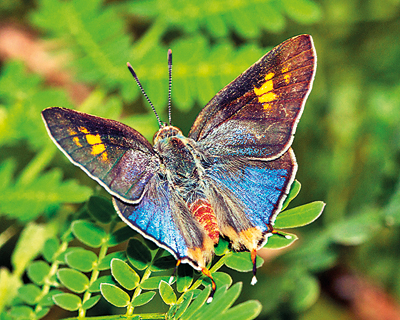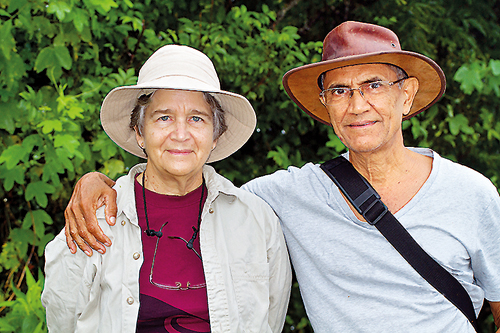Getting to know all about those flitting beauties

Ceylon Silverline- Male
Adam’s Peak is known as ‘Samanala Kanda’ (Butterfly Mountain) because large numbers of butterflies fly towards it during the pilgrim season. According to folklore these butterflies fly to pay tribute to the mountain and with the Adam’s Peak season starting next week, this is probably the best time to launch the ‘Field Guide to Butterflies of Sri Lanka’.
This field guide is by Dr. Michael van der Poorten, the acclaimed butterfly expert together with his wife Dr.Nancy van der Poorten. The authors’ 2016 book ‘The Butterfly Fauna of Sri Lanka’ was widely hailed as a landmark publication for its comprehensive coverage of the biology of the butterflies of Sri Lanka. But it was a large heavy book which was difficult to carry around; so the need for a small, easy-to-carry book that could be taken out to the field arose, giving birth to this compact field guide.
The guide provides a wealth of information on all of Sri Lanka’s 248 butterflies. Each butterfly is described with key information on its appearance, behaviour, habitat, flight period and prime locations for observation. The guide carries close-up images of butterflies taken from different angles featuring the most distinguishable features.
The butterflies of Sri Lanka are broadly grouped as Skippers, Blues, Brush-foots, Swallowtails, Metalmarks, Whites and Yellows. While a swallowtail butterfly could be distinguished easily from a skipper butterfly, some species within the groups are difficult to separate as the markings differentiating them could be hard to pick. While images point out these features, the guide additionally provides ‘identification keys’ assisting identification.

The authors: Nancy and Michael van der Poorten
The book is arranged by grouping together those species that look similar rather than by taxonomic order that scientists often use. This is a notable difference as it helps butterfly enthusiasts to identify a butterfly in the field.The detailed distribution maps showing current and historical records of the range of different butterfly species is another feature that is quite useful to verify specially the sighting of some rare butterflies.
Talking on the challenge of getting a good butterfly photograph, Dr.van der Poorten advises that a macro lens from 100 to 200 mm is a useful tool. But patience is what is absolutely essential if you decide to follow butterflies. The time of day too is important; the best time for photography is early morning when the butterflies start to warm up; many will open their wings when settled only at this time, our butterfly expert added.
Most of our gardens are visited by at least a few species of butterflies, so they are special creatures that can bring the beauty of nature to our own doorstep. In the chapter “Through the eyes of a butterfly” the authors give guidance to those who would like to make their garden butterfly-friendly. “In order to have a flourishing butterfly garden, you need to see the space through the eyes of a butterfly: what are the resources that butterflies need to survive. What will attract them to the garden and what will keep them around and prevent their departure elsewhere”. Butterflies are undoubtedly so beautiful and harmless that they are a great introduction for kids, so make your garden ‘butterfly friendly’, Dr.van der Poorten urges.
The Field Guide to the Butterflies of Sri Lanka by Michael and Nancy van der Poorten will be launched on December 20 at 6 p.m. at the Met Department Auditorium, Bauddhaloka Mawatha, Colombo 7. The field guide is priced at Rs. 4,500, but can be purchased at the launch at Rs.3,000.


